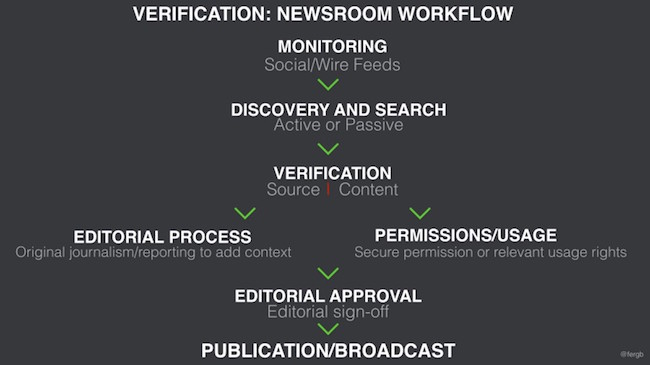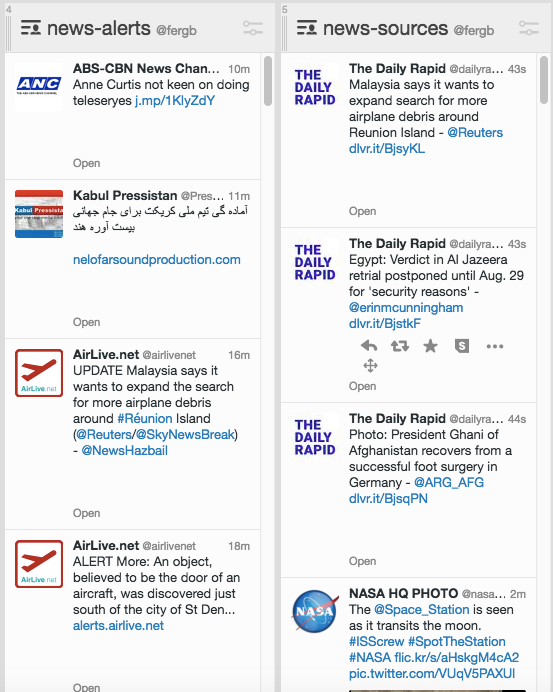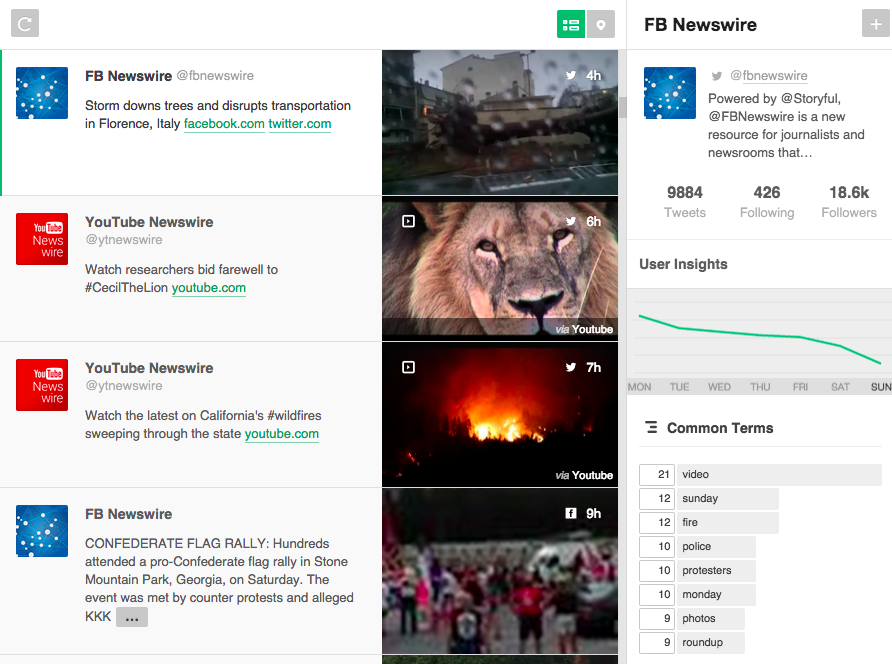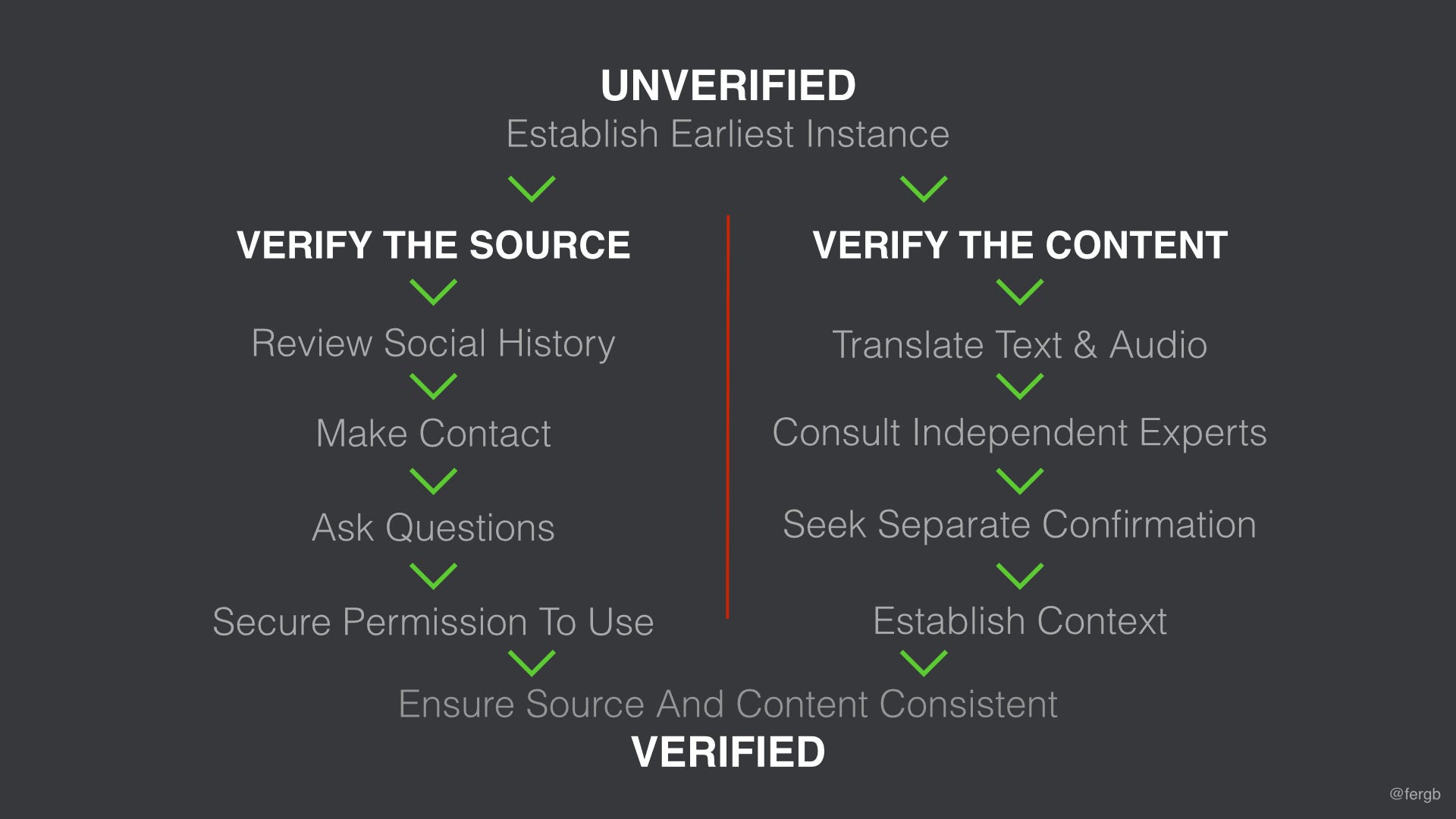This is the first part in a two-part series on newsroom workflows for eyewitness media. Read the second part here.

Knowing how to monitor multiple feeds or accounts for large amounts of content is essential to break or react to news in any market. It isn’t just about filtering what you are looking at, but also being smart about how you are looking at it. Establishing a good monitoring process can ensure you are always competitive, as well as helping you to unearth complementary information or content for existing reporting.

Twitter lists as seen in Tweetdeck
Using the right toolset for your monitoring needs is vital. You and your colleagues in the newsroom need to be comfortable with everything you use. In most cases, this will mean using fewer tools, but using them effectively.
If you have the luxury of multiple computer monitors you could dedicate a whole screen to a monitoring tool, freeing up other screens for search and email, or your production systems. If you don’t, then you need to be more streamlined.
For monitoring social feeds, you can start with free tools from Twitter such as Twitter Lists and Tweetdeck, but there are also a number of paid or freemium tools out there that provide great monitoring solutions.

Monitoring YouTube Newswire and Facebook Newswire updates using SAM Desk (disclaimer: author has existing professional relationship with this organisation)
Something with pop-up notifications can be really useful if you are tight on screen real-estate but what is most important is that you are able to see relevant content as quickly as possible.

I also want to flag the importance of setting up searches for the purpose of monitoring. Consider the people who are at the scene of breaking news and the type of language they might use when uploading information or content.
The screenshot on the right is from my Tweetdeck, showing a simple Boolean search that has proven to be very useful in the past. True, most of the content isn’t newsworthy at all but it still pays dividends to check it now and again.
You might also want to add terms that link to upload destinations. For example, coupling search terms with the shortened YouTube URL “youtu.be” can show up UGC very quickly.
In the newsroom
Monitoring social should be a part of the newsgathering process for any newsroom so it is worth considering if these duties would best be carried out by newsgathering or intake teams, rather than writing or production. Getting the system right can save any newsroom that might be short on resources a lot of time. The by-product of good monitoring is that outside of breaking news you will also find more content for your output.
Key workflow:
Consolidate the number of windows, sites or tools for each person tasked with monitoring for UGC, setting up a standard workflow that can be integrated and implemented into your organisations existing training structure. Work out the most efficient system for sharing monitoring systems between staff and shifts.
Discovery (and search)
The discovery of social content can be split into two distinct areas.
Active discovery
This kind of discovery occurs either when your monitoring tools provide the existence and location of user-generated content, or you perform your own regular searches.
Passive discovery

Screengrab from Dataminr
This is when you are alerted to content without knowing that it — or the event itself — even exists yet. Tools like Dataminr, Krzana, Google Trends or Facebook Trends can all inform you of something that you might not be aware of. In newsroom terms this is usually unverified, raw information that is lacking context. Putting this through the verification process is essential, regardless of the source.
The most common way for someone working with social newsgathering to learn about something through passive discovery is from within their own organisation: tip-offs to the newsdesk, reporters calling it in or the news breaking on the wire.
This information is likely to be verified to some extent, even if it is just because a reporter has thought it credible enough to pass on. Having a head start on the search for UGC, especially if a location is known, can be hugely important for getting content first and, most importantly, verifying it.
In the newsroom
Open communication channels between desks and staff is incredibly important. When it comes to UGC and verification the more eyes that see a piece of content the more chance you have of identifying whether you have seen it from another social source, whether it is from an old event, or even whether it is material that is actually from another news source.
If a newsroom has the luxury of a dedicated person (or even people) then close proximity to the news desk is essential for quick communication of both the breaking news event itself and any UGC that might be emerging. Communication needs to work both ways so that information emerging from within the organisation filters through to the UGC staffer as quickly as possible, in order to assist competitive searching.
With content that appears on digital channels it is very easy to view it on personal computers but often greater visibility within the newsroom will aid verification from the professionals around you.
Key workflow: Establish the quickest way for the person monitoring for UGC to communicate it to the relevant editor in order to take further action, verification being the next step. Establish communication channels for internal tip-offs or monitoring of other (non-social) sources to get to the person responsible for UGC as quickly as possible. Consider how you can visually display UGC that is due to be verified for colleagues in the newsroom, before it is published or broadcast.
Verification

It is essential that you have a thorough UGC/social media verification process that your newsroom is comfortable implementing in the most pressurised or competitive situations. If you get something wrong here it can undermine any effort you have put into workflow elsewhere.
In the newsroom
Verification can only work if all those involved know the process and are invested in it. It is therefore important to map out all of the steps and be sure to base it on a model that works for all kinds of news scenarios. Every single person in a newsroom will have a unique skill that might help the organisation verify a specific piece of content faster and more accurately than anyone else.
Ultimately what you are trying to do is build up a case for why the UGC is authentic. Much like the legal system it can be more helpful to assume innocence and authenticity from uploaders, rather than guilt or fakery. Verification often comes down to ascertaining the exact timing, location and context rather than whether something has faked or doctored.
Important tip:
If you establish that you are not chasing the right source or that the content is fake, or not from the event you are chasing then…STOP!
Unless you have an outlet for debunking stories your time is likely better spent chasing content that is actually genuine. If something is not right, you don’t need to spend any more time proving how fake it might be. Instead, move on to the next source, video, photo, lead and find something you can stand up for your organisation.
Key workflow: Ensure that the verification process is clear and understood by all of those involved in the process at all levels in the organisation. Test the verification workflow with key stakeholders before the pressure of a breaking news situation and make sure that it can work in a number of different scenarios or types of media.
To be continued…



